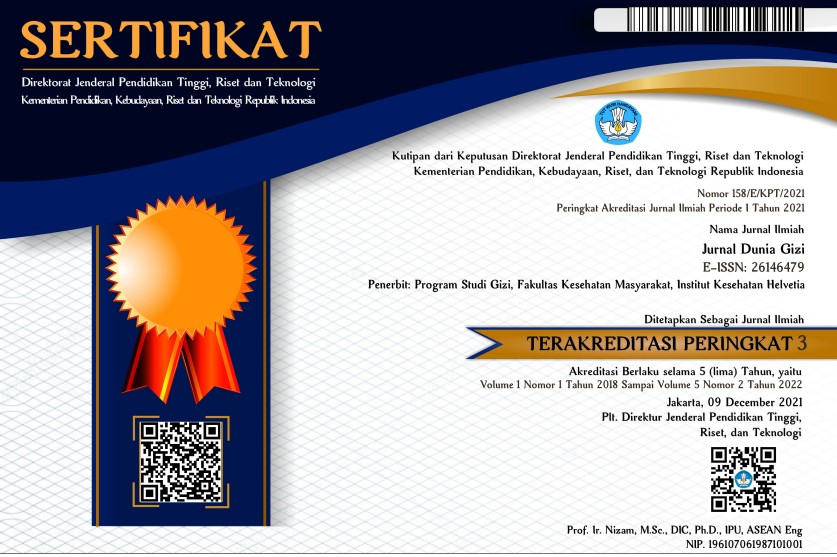Correlation betwen Fiber Intake and Energy Adequacy Based on 7-Days food diary of primary school children age 8-12 years in Surakarta
Abstract
Background; The dietary fiber intake is an important part of childern’s diet and has a role in development of non-commuicable disease. The percentage of fiber intake based on the consumption of fruit and vegetables has been reported lack of children in Surakarta. Purposes; The aim of this research were to analyse the correlation between fiber intake and energy adequacy and to assess the contribution of food source containing fiber to energy intake of primary school children age 8-12 years old in Surakarta. Method; This type of this research was observational with a cross sectional approaches. One hundred and thirteen elementary school children age 8-12 years old in Surakarta were participated in this study which were recruited using multistage random sampling. The intakes data were analysed used Nutrisurvey fo Windows 2007 based on 7-days food diary filled by each child under her/his parent supervision. Dietary Allowance Intake for Indonesia called AKG 2013 was used as a refernce intake. Correlation test used Chi-Square. Result; Median fiber intake and energy adequacy of all children were 3.11 gram/day and 42% respectively. There was no correlation between fiber and energy adequacy intake (p=0.05). Food source contributed fiber intake were white rice, processed flur products, and other vegetable food such as carrots, guava, and fermented soybean or tempeh. Conclusion; The low fiber intake in school age 8-12 years old in Surakarta was not correlated with their low energy adequacy.
Keywords
Full Text:
PDFReferences
Shinozaki K, Okuda M, Sasaki S, Kunitsugu I, Shigeta M. Dietary Fiber Consumption Decreases The Risks of Overweight and Hypercholesterolemia in Japanese Children. Ann Nutr Metab 2015;67(1):58-64.
Fujii H, Iwase M, Ohkuma T, Ogata-Kaizu S, Ide H, Kikuchi Y, et al. Impact of Dietary Fiber Intake on Glycemic Control, Cardiovascular Risk Factors and Chronic Kidney Disease In Japanese Patients With Type 2 Diabetes Mellitus: The Fukuoka Diabetes Registry. Nutrition Journal 2013;12(159):1-8.
Ruiz E, Ávila JM, Valero T, Pozo S Del, Rodriguez P, Aranceta-Bartrina J, et al. Energy Intake, Profile, And Dietary Sources in The Spanish Population: Findings of The ANIBES Study. Nutrients 2015;7(1):4739-4762.
Kementrian Kesehatan RI. Hasil Riset Kesehatan Dasar. Kementrian Kesehatan RI. 2018.
Kementrian Kesehatan RI. Hasil Riset Kesehatan Dasar. Kementrain Kesehatan RI. 2013.
Kementrian Kesehatan RI. Riset Kesehatan Dasar Dalam Angka Provinsi Jawa Tengah. Kementrian Kesehatan RI. 2013.
Kementrain Kesehatan RI. Pedoman Gizi Seimbang. Kementerian Kesehatan RI. 2014.
Sardinha AN, Canella DS, Martins APB, Claro RM, Levy RB. Dietary Sources of Fiber Intake in Brazil. Appetite 2014;79(1):134-138.
Brauchla M, Juan W, Story J, Kranz S. Sources of Dietary Fiber and The Association of Fiber Intake with Childhood Obesity Risk (In 2-18 Year Olds) and Diabetes Risk of Adolescents 12-18 Year Olds: NHANES 2003-2006. J Nutr Metab 2012;2012(1):1-7.
McGill CR, Fulgoni VL, Devareddy L. Ten-Year Trends in Fiber and Whole Grain Intakes and Food Sources for The United States Population: National Health and Nutrition Examination Survey 2001-2010. Nutrients 2015;7(2):1119-1130.
Nurwanti E, Hadi H, Julia M. Faktor Risiko Terjadinya Obesitas pada Anak Sekolah Dasar Kota dan Desa di Daerah Istimewa Yogyakarta. Jurnal Gizi dan Diet Indonesia 2013;1(2):59-70.
Kementrian Kesehatan RI. Foto Buku Makanan. Kementrian Kesehatan RI. 2014.
Kementrian Kesehatan RI. Angka Kecukupan Gizi. Kementrian Kesehatan RI. 2019.
Aburto TC, Pedraza LS, Sánchez-Pimienta TG, Batis C, Rivera JA. Discretionary Foods Have a High Contribution and Fruit, Vegetables, and Legumes Have a Low Contribution to the Total Energy Intake of the Mexican Population. J Nutr. 2016;146(9):1881-1887.
Rolls BJ. The relationship between Dietary Energy Density and Energy Intake. Physiol Behaviour 2009;97(5):609-615.
Kementrian Pertanian RI. Satistika Konsumsi Pangan. Kementrian Pertanian. 2018.
Infodatin. Konsumsi Makanan Penduduk Indonesia. Kementrian Kesehatan RI. 2018.
Ronitawati P, Setiawan B, dan Sinaga T. Analisis konsumsi buah dan sayur pada model sistem penyelenggaraan makanan di Sekolah Dasar. IPB. 2016.
Mohammad A, Madanijah S. Konsumsi Buah dan Sayur Anak Usia Sekolah Dasar di Bogor. Jurnal Gizi dan Pangan 2015;10(1):71-76.
Kementrian Kesehatan RI. Tabel Komposisi Pangan Indonesia. Kementrian Kesehatan RI. 2017.
Pardede E. Tinjauan Komposisi Kimia Buah dan Sayur: Peranan Sebagai Nutrisi dan Kaitannya dengan Teknologi Pengawetan dan Pengolahan. Jurnal VISI 2014;21(3):1-16.
Santoso, Budi, dkk. Buku Studi Diet Total Jawa Tengah. Balitbang Kementrian Kesehatan RI. 2014.
Puspamika D. Konsumsi Serat pada Anak Sekolah Dasar Kota Denpasar. Community Health 2014;2(1):133-140.
Prihatini H dan. Gambaran Konsumsi Sayur dan Buah Penduduk Indonesia dalam Konteks Gizi Seimbang : Analisis Lanjut Survei Konsumsi Makanan Individu. Buletin Penelitan Kesehatan 2016;44(3):205-218.
Lestari A. Faktor-faktor yang Berhubungan dengan Perilaku Konsumsi Buah dan Sayur pada Siswa SMPN 226 Jakarta Selatan Tahun 2012 FKIK UIN Jakarta. 2013.
Iqlima, Nurul. Gambaran Pemilihan Makanan Jajanan Pada Anak Usia Sekolah Dasar. Jurnal Keperawatan BSI 2017;5(1):8-17.
Nugroho KPA, Sanubari TPE, dan Rosalina S. Gambaran Tingkat Asupan Gizi Anak Sekolah Dasar Negeri 06 Salatiga. Jurnal Kesehatan Kusuma Husada 2019;10(1):94-101.
DOI: https://doi.org/10.33085/jdg.v3i1.4654
Refbacks
- There are currently no refbacks.

This work is licensed under a Creative Commons Attribution-NonCommercial 4.0 International License.









1.png)







.png)










